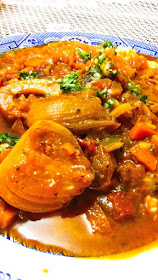Real men don't eat quiche. Indeed. This was the title of an article in a girlie magazine of way back when. The idea was reiterated recently in a local beer ad here in South Africa that had it that real men don't drink pink drinks.
The idea probably rides on the macho image of South Africans as serious meat eaters. I tend to agree, but certainly took this magazine article as a challenge. The same sort of challenge that our English language teacher posed to us in class on the subject of essay themes.
He would set us a theme, then add that it stands us free to rather write an essay under the title “My Dog Spot” instead. He offered to then mark such essay accordingly. I often toyed with the idea of writing such essay in addition to the regular set theme, then hand it in, marked as my entry to his challenge. Sadly, I never did. It would have been a great opportunity to write something extraordinary and creative on such an inane subject. A chance to really think up something with a twist.
On a recent upcountry road trip we chanced to stop for lunch in the delightful town of Senekal in the Free State province. It was a balmy day and we were on our way to the stopover at Colesberg, still some distance away. At the bottle store we made enquiries as to a quiet place for a light lunch and was directed to a local coffee shop where we had the most delicious quiche imaginable.
The old magazine article immediately sprung to mind and the idea of a challenge was born. Busting some myths, no less.
Real men don't eat quiche. Yea, right.
 So, having taken up the challenge, I did some searching on the internet and found, as usual, a myriad of recipes. There are plenty examples of quiche using various vegetables as well. Having taken bold the step of going outside of manly machismo, I decided to make a classic quiche, just because of the value of the challenge. Perhaps also because it is the festive season and holiday weather here in the Cape. And, after all, it is some form of culinary adventure. The recipe is adapted from several on the internet, with a view of having a classic rich version that is easy to make.
So, having taken up the challenge, I did some searching on the internet and found, as usual, a myriad of recipes. There are plenty examples of quiche using various vegetables as well. Having taken bold the step of going outside of manly machismo, I decided to make a classic quiche, just because of the value of the challenge. Perhaps also because it is the festive season and holiday weather here in the Cape. And, after all, it is some form of culinary adventure. The recipe is adapted from several on the internet, with a view of having a classic rich version that is easy to make.
Here is my humble attack on the myth of real men not eating quiche.
Quiche Lorraine a la The Hungry Sailor.
Ingredients
For the crust
1 cup cake flour
1/3 cup real butter or shortening
1/4 teaspoon salt
2-3 dessert spoons water as required.
For the filling
250 ml cream
250 ml full fat cottage cheese
3 large eggs, slightly beaten
Sprig of parsley, chopped
½ of a medium size onion, grated
1 cup bacon, diced
¼ teaspoon ground nutmeg
½ cup grated cheddar cheese
½ teaspoon smoked paprika
 Process
Process
 We start with the crust. I made this one in an aluminium foil pie dish, as I do not possess a porcelain or stoneware version. Dice and chill the butter. Mix the flour and salt, then rub the butter into the flour. Add just enough water to make it the consistency of dry wall plaster or dry-ish plasticine. It should not be runny at all. Spray the pie dish with a suitable release agent or butter the dish. Line the pie dish with the dough, pressing it down and making sure it has an even thickness all around. Roll it out flat if you want to. Park this in the refrigerator while the oven heats up.
We start with the crust. I made this one in an aluminium foil pie dish, as I do not possess a porcelain or stoneware version. Dice and chill the butter. Mix the flour and salt, then rub the butter into the flour. Add just enough water to make it the consistency of dry wall plaster or dry-ish plasticine. It should not be runny at all. Spray the pie dish with a suitable release agent or butter the dish. Line the pie dish with the dough, pressing it down and making sure it has an even thickness all around. Roll it out flat if you want to. Park this in the refrigerator while the oven heats up.
The oven should be heated to 200ºC/400ºF. Bake the cold crust for ten minutes, then remove from the oven. Allow the crust to cool. Remember that it is now very brittle, so don't bump it.
The filling is prepared as follows: Fry the bacon lightly until almost done, then drain on a piece of paper towel. Grate the onion and drain it on some paper towel as well. You don't want too much of the onion water in your filling. If you have reservations of grating the onion, just chop it finely, like I did. The onions go into the filling raw, so you don't want large pieces.
 Mix the cottage cheese and cream thoroughly. Add in the eggs. You may beat the cream beforehand till it just goes slightly stiff. Now mix in the onion and parsley and add some nutmeg to taste.
Mix the cottage cheese and cream thoroughly. Add in the eggs. You may beat the cream beforehand till it just goes slightly stiff. Now mix in the onion and parsley and add some nutmeg to taste.
Building the final product is easy. Spread the bacon in the bottom of the crust, then pour in the cream and cheese mix. Sprinkle some grated cheddar cheese on top, along with a whiff of smoked paprika.
Carefully put this assembly into the oven at 180ºC/350ºF. If you think you may have a mishap and break the crust or spill the filling, assemble the quiche on the oven rack itself. It may make your life easier. Use an oven pan under the dish, as it may spill as it cooks. Now bake this for about 20-25 minutes. Allow the quiche to cool down properly before attempting to cut it. It is good when warm, but it will be quite brittle and soft when you take it out of the oven.
This quiche was easy to make, my first one. It is quite tasty and not nearly as rich as one would imagine. Goes well with a fresh garden salad. This dish can be eaten cold as well.
Bon appetit!
Authored by Johan Zietsman
Last updated on 2015-12-02














































